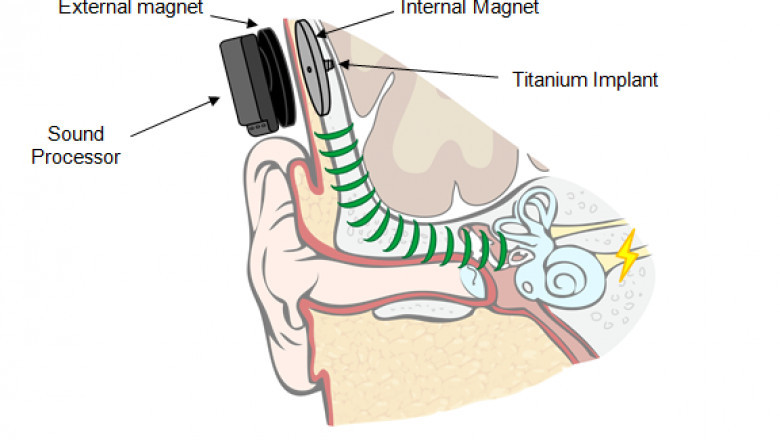views

Imagine listening to music, taking calls, or immersing yourself in a podcast—without anything in or on your ears. No earbuds. No headsets. Just clear, private audio streamed directly through your skull. Sounds like science fiction? Welcome to the future of sound: bone conduction implants.
In this blog, we’ll explore what bone conduction implants are, how they work, their potential benefits and risks, and why they might become the next frontier in personal audio technology.
What Is Bone Conduction?
Before diving into implants, let’s understand the science.
Bone conduction is a way of transmitting sound not through the air (as traditional headphones do) but through your bones—specifically the bones in your skull. Vibrations from a speaker or device travel through the bone and directly stimulate the cochlea (the hearing part of the inner ear), bypassing the eardrum entirely.
It’s the same reason your voice sounds deeper when you speak—it travels through your skull to your ears.
What Are Bone Conduction Implants?
Bone conduction implants are surgically inserted devices that allow you to hear sound via bone conduction without needing external headphones. Unlike traditional bone conduction headphones that rest on your cheekbones or temples, these implants are integrated into your skull or behind your ear.
These devices are currently used in certain medical contexts—especially for people with conductive hearing loss or single-sided deafness. But the technology is evolving rapidly and may soon be marketed for mainstream audio consumption.
How Do Bone Conduction Implants Work?
Here's a simple breakdown of how these futuristic audio devices work:
-
Implantation: A small transducer is implanted under the skin, usually near the temporal bone (just behind the ear).
-
Signal Transmission: A paired external device (like a smartphone or wearable controller) sends a digital audio signal wirelessly to the implant.
-
Bone Vibration: The implant converts the signal into vibrations.
-
Direct Hearing: These vibrations stimulate the cochlea, bypassing the middle and outer ear entirely.
Why Are Bone Conduction Implants Gaining Interest?
Several major trends are fueling the excitement around this technology:
1. Hands-Free, Wear-Free Audio
No need to carry earbuds, worry about battery life, or deal with tangled wires. You become the device.
2. Discreet Listening
Because the sound doesn’t travel through the air, it’s inaudible to people nearby. Perfect for private calls or immersive audio in public spaces.
3. Preserves Situational Awareness
Your ears remain open to ambient sounds. This is a game-changer for runners, cyclists, or anyone navigating noisy urban environments.
4. Potential for Smart Integration
Implants could be integrated with other tech—like health monitoring, AI assistants, or augmented reality—making them part of a larger body-computer interface.
Current Use in Medicine
Bone conduction implants like the BAHA (Bone Anchored Hearing Aid) or Osia System are already approved for medical use. These systems help people with:
-
Chronic ear infections
-
Congenital ear malformations
-
Single-sided deafness
-
Conductive/mixed hearing loss
These implants show that bone conduction through implanted devices is not only possible but highly effective.
Challenges and Concerns
While the technology is promising, there are several challenges:
1. Surgical Invasiveness
Getting an implant requires surgery. This raises concerns about safety, cost, and public willingness to undergo a procedure for non-medical reasons.
2. Cost and Accessibility
Current implants are expensive and typically covered by insurance only for medical needs. Making them affordable and mainstream would require a shift in manufacturing and regulation.
3. Security and Privacy
Wireless data transmission into your body? That opens questions about data privacy, cybersecurity, and potential misuse.
4. Health Risks
Long-term effects of having electronic components in the skull, while not well-documented yet, need more research.
The Future of Audio Tech: In Your Skull?
We’re entering an era where technology isn’t just wearable—it’s embeddable. Just like smartwatches have become health monitors, bone conduction implants could turn your head into the ultimate audio device. Companies like Elon Musk’s Neuralink and startups in the neurotech space are already exploring brain-computer interfaces, of which bone conduction audio could be a critical component.
Ethical and Cultural Questions
Would you implant a device in your skull just to get better sound quality? For some, the answer might be yes. But it also raises ethical concerns:
-
Would employers push this tech for constant communication?
-
Could governments use it for surveillance?
-
What happens to individuality when our thoughts and audio are directly connected to machines?
Final Thoughts: Are We Ready?
Bone conduction implants might sound like a leap into the unknown, but the technology is already here—just not yet mainstream. The benefits in sound clarity, privacy, and hands-free design are enormous. But the path to widespread adoption depends on how we handle the risks, costs, ethics, and human willingness to fuse with machines.
Whether you’re ready or not, the next generation of headphones might not sit on your head—they might live inside it.












Comments
0 comment